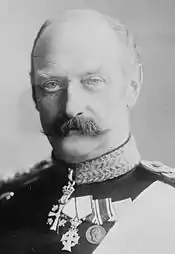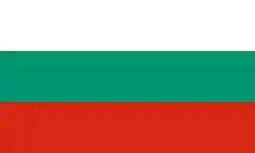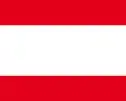Frederick VIII of Denmark
Frederick VIII (Danish: Christian Frederik Vilhelm Carl; 3 June 1843 – 14 May 1912) was King of Denmark from 1906 to 1912. Before his accession to the throne at age 62, he served as crown prince for over 42 years. During the long reign of his father, King Christian IX, he was largely excluded from influence and political power.[1]
| Frederick VIII | |||||
|---|---|---|---|---|---|
 Painting by Otto Bache, 1910 | |||||
| King of Denmark (more...) | |||||
| Reign | 29 January 1906 – 14 May 1912 | ||||
| Predecessor | Christian IX | ||||
| Successor | Christian X | ||||
| Prime Ministers | |||||
| Born | Prince Frederick of Schleswig-Holstein-Sonderburg-Glücksburg 3 June 1843 Yellow Palace, Copenhagen, Denmark | ||||
| Died | 14 May 1912 (aged 68) Hamburg, German Empire | ||||
| Burial | |||||
| Spouse | |||||
| Issue Detail | |||||
| |||||
| House | Glücksburg | ||||
| Father | Christian IX of Denmark | ||||
| Mother | Louise of Hesse-Kassel | ||||
| Religion | Lutheran | ||||
Early life

.jpeg.webp)

Frederick was born on 3 June 1843 in the Yellow Palace, an 18th-century town house at 18 Amaliegade, immediately adjacent to the Amalienborg Palace complex in Copenhagen.[2] He was the eldest son and child of Prince Christian of Schleswig-Holstein-Sonderburg-Glücksburg and Princess Louise of Hesse-Kassel-Rumpenheim.[2][3] His father's family was a cadet branch of the Danish royal House of Oldenburg, which was descended from Christian III and which had ruled as non-sovereign dukes in Schleswig-Holstein for eight generations. He had five younger siblings: Alexandra (1844-1925), William (1845-1913), Dagmar (1847-1928), Thyra (1853-1933) and Valdemar (1858-1939). Although they were of royal blood,[4] the family lived a comparatively normal life. They did not possess great wealth; their father's income from an army commission was about £800 per year and their house was a rent-free grace and favour property.[5] Occasionally, Hans Christian Andersen was invited to call and tell the children stories before bedtime.[6]
In 1853, it was clear that the main line of the Oldenburg dynasty would become extinct with King Frederick VII, who was elderly and childless. Frederick's mother was very close to the succession, as she was a niece of the previous Oldenburg king, Christian VIII, through his sister. With the other heirs from the House of Hesse-Kassel having renounced their claims to the Danish throne in favour of Louise, who in turn relinquished her own claim, his father was eventually chosen as the heir presumptive. Accordingly, Frederick was created a Prince of Denmark.[7]
After his confirmation in 1860, Prince Frederick was given an extensive military education, pursuing a career in the Royal Danish Navy alongside his brother William. In 1863, Frederick was sent to study political science at the University of Oxford, but returned to Denmark upon his father becoming king in November that year. As heir apparent to the throne, he was given a seat in the State Council and subsequently assisted his father in the duties of government. In 1864, he formally took part in the Second Schleswig War against Prussia and Austria.
The crown prince was a member of the Danish Order of Freemasons, serving as its Grand Master from 1871 until his death.[8]
Marriage
Queen Louise wanted her eldest son to marry as well as had her two daughters, Alexandra and Dagmar. Queen Victoria of the United Kingdom had two yet unmarried daughters, Princess Helena and Princess Louise, and Louise planned to have Frederick marry one of them. However, Victoria did not want her daughters to marry heirs to foreign thrones, as this would force them to live abroad, instead preferring German princes who could establish homes in England. In addition, Victoria had always been pro-German and another Danish alliance (Frederick's sister, Alexandra, had married Victoria's eldest son Edward, Prince of Wales), would not have been in line with her German interests.[9][10]
In July 1868, Crown Prince Frederick—then 25 years old—became engaged to Princess Louise, the 17-year-old only daughter of King Charles XV of Sweden. Princess Louise belonged to the Bernadotte dynasty, which had ruled in Sweden since 1818, when the founder, Jean-Baptiste Bernadotte, one of Napoleon Bonaparte's generals, was elected crown prince of Sweden in 1810 and later succeeded the throne as King Charles XIV John in 1818. He married Désirée Clary, who had once been engaged to the French Emperor. Charles XIV's son, Oscar I, had married Josephine of Leuchtenberg, the granddaughter of Napoleon's first wife, the Empress Josephine. King Oscar I and Queen Josephine were Princess Louise's paternal grandparents.[11]
The marriage was suggested as a way of creating friendship between Denmark and Sweden. Relations between the two countries had been tense after Sweden had not assisted Denmark during the war with Prussia in 1864. Frederick and Louise had met for the first time in 1862, but in 1868 Frederick was invited to Sweden to get to know Louise, and their meeting was described as a success. A year later they were married in the chapel at the Royal Palace in Stockholm on 28 July 1869. Louise was the first Swedish princess to be married into the Danish royal house since the Middle Ages, and the marriage was welcomed in all three Scandinavian countries as a symbol of the new Scandinavism.
Frederick and Louise resided at Amalienborg Palace in Copenhagen, spending the summers at Charlottenlund Palace north of the city. They had four sons and four daughters; their eldest sons, Christian and Carl, would become kings of Denmark and Norway respectively.[12][13][14]
Reign


Frederick became king of Denmark upon his father's death on 29 January 1906. In many ways, Frederick VIII was a liberal monarch who was much more favorable to the new parliamentarian system than his father had been, being reform-minded and democratically inclined.
Due to his late accession to the throne, Frederick's reign would last only six years, throughout which he was plagued by ill health.
Death
On 14 May 1912, while on his return journey from a trip to Nice with his wife and four of his children, the king made a short stop in Hamburg, staying at the Hotel Hamburger Hof under the pseudonym "Count Kronsberg". That evening, Frederick—while incognito—went out for a stroll on the Jungfernstieg, during which he became faint and collapsed on a park bench at Gänsemarkt. He was discovered by a police officer who took him to the hospital, where he was pronounced dead; his cause of death was announced as a heart attack. As Frederick was incognito at the time and had no papers on him, his body was brought to the local morgue, where he was identified by the hotel manager the next morning.
False rumors soon began to circulate about a possible scandal involving the king, as the place where he collapsed and died at was near a well-known brothel. The local police did not disclose details about the investigation, for fear of causing distress to the royal family.[15]
Frederick's body was transported via a special train to Travemünde, after which he was brought back to Denmark by the royal yacht Dannebrog. He was interred with other members of the Danish royal family in Roskilde Cathedral near Copenhagen.
Legacy
The reigning families of Denmark, Norway, Belgium and Luxembourg are descended from King Frederick VIII; Denmark's through his eldest son Christian X, and Norway's through his second son, Haakon VII. The royal family of Belgium and grand ducal family of Luxembourg are both descended from his daughter, Princess Ingeborg of Denmark.[16]
Titles, styles and honours
| Styles of Frederick VIII of Denmark | |
|---|---|
 | |
| Reference style | His Majesty |
| Spoken style | Your Majesty |
Titles and styles
- 3 June 1843 – 31 July 1853: His Highness Prince Frederick of Schleswig-Holstein-Sonderburg-Glücksburg
- 31 July 1853 – 21 December 1858: His Highness Prince Frederick of Denmark
- 21 December 1858 – 15 November 1863: His Royal Highness Prince Frederick of Denmark
- 15 November 1863 – 29 January 1906: His Royal Highness The Crown Prince of Denmark
- 29 January 1906 – 14 May 1912: His Majesty The King of Denmark
Honours
The Kronprins Frederiks Bro in Frederikssund and King Frederick VIII Land in Greenland are named after him.
National orders and decorations[17]
- Knight of the Elephant, 3 June 1861
- Cross of Honour of the Order of the Dannebrog, 3 June 1861
- Grand Commander of the Dannebrog, 28 July 1869
- Commemorative Medal for the Golden Wedding of King Christian IX and Queen Louise, 1892
Foreign orders and decorations[18]
 Ascanian duchies: Grand Cross of Albert the Bear, 4 April 1863[19]
Ascanian duchies: Grand Cross of Albert the Bear, 4 April 1863[19].svg.png.webp) Austria-Hungary: Grand Cross of St. Stephen, 1873[20]
Austria-Hungary: Grand Cross of St. Stephen, 1873[20].svg.png.webp) Baden:[21]
Baden:[21]
- Knight of the House Order of Fidelity, 1881
- Knight of the Order of Berthold the First, 1881
.svg.png.webp) Bavaria: Knight of St. Hubert
Bavaria: Knight of St. Hubert.svg.png.webp) Belgium: Grand Cordon of the Order of Leopold
Belgium: Grand Cordon of the Order of Leopold Bulgaria:
Bulgaria:
.svg.png.webp)
.svg.png.webp)
.svg.png.webp) Ernestine duchies: Grand Cross of the Saxe-Ernestine House Order
Ernestine duchies: Grand Cross of the Saxe-Ernestine House Order.svg.png.webp) France: Grand Cross of the Legion of Honour
France: Grand Cross of the Legion of Honour.svg.png.webp) Greece: Grand Cross of the Redeemer
Greece: Grand Cross of the Redeemer.svg.png.webp) Hawaii: Grand Cross of the Order of Kalākaua
Hawaii: Grand Cross of the Order of Kalākaua Hesse-Darmstadt: Grand Cross of the Ludwig Order, 5 May 1865[22]
Hesse-Darmstadt: Grand Cross of the Ludwig Order, 5 May 1865[22]_crowned.svg.png.webp) Italy: Knight of the Annunciation, 10 May 1875[23]
Italy: Knight of the Annunciation, 10 May 1875[23].svg.png.webp) Japan: Grand Cordon of the Order of the Chrysanthemum, 18 May 1888[24]
Japan: Grand Cordon of the Order of the Chrysanthemum, 18 May 1888[24] Mecklenburg: Grand Cross of the Wendish Crown, with Crown in Ore and Diamonds, 1884[25]
Mecklenburg: Grand Cross of the Wendish Crown, with Crown in Ore and Diamonds, 1884[25] Netherlands: Grand Cross of the Netherlands Lion
Netherlands: Grand Cross of the Netherlands Lion.svg.png.webp) Nassau Ducal Family: Knight of the Gold Lion of Nassau
Nassau Ducal Family: Knight of the Gold Lion of Nassau Oldenburg: Grand Cross of the Order of Duke Peter Friedrich Ludwig, with Golden Crown
Oldenburg: Grand Cross of the Order of Duke Peter Friedrich Ludwig, with Golden Crown.svg.png.webp) Ottoman Empire: Order of Osmanieh, 1st Class in Diamonds
Ottoman Empire: Order of Osmanieh, 1st Class in Diamonds.svg.png.webp) Portugal:
Portugal:
- Grand Cross of the Military Order of Christ[17]
- Grand Cross of the Tower and Sword
- Grand Cross of the Immaculate Conception of Vila Viçosa
- Grand Cross of the Sash of the Three Orders
.svg.png.webp) Prussia:
Prussia:
- Knight of the Black Eagle, with Collar
- Grand Cross of the Red Eagle
 Romania:
Romania:
 Russia:
Russia:
- Knight of St. Andrew
- Knight of St. Alexander Nevsky
- Knight of the White Eagle
- Knight of St. Anna, 1st Class
- Knight of St. Stanislaus, 1st Class
- Knight of St. Vladimir, 4th Class
.svg.png.webp) Saxe-Weimar-Eisenach: Grand Cross of the White Falcon, 1882[26]
Saxe-Weimar-Eisenach: Grand Cross of the White Falcon, 1882[26].svg.png.webp) Siam:
Siam:
- Knight of the Order of the Royal House of Chakri, 15 July 1897[27]
- Grand Cross of the White Elephant
.svg.png.webp) Spain: Knight of the Golden Fleece, 19 April 1883[28]
Spain: Knight of the Golden Fleece, 19 April 1883[28].svg.png.webp)
 Sweden-Norway:
Sweden-Norway:
- Grand Cross of St. Olav, with Collar, 18 July 1862[29]
- Knight of the Seraphim, with Collar, 7 August 1862[30]
- Knight of the Order of Charles XIII, 4 November 1871[31]
- Commander Grand Cross of the Sword
 United Kingdom:
United Kingdom:
- Honorary Grand Cross of the Bath (civil), 10 March 1888[32]
- Stranger Knight of the Garter, 21 July 1896[33]
- Honorary Grand Cross of the Royal Victorian Order, 8 March 1901[34]
- Royal Victorian Chain, 9 August 1902[35]
- Honorary military appointments
- Colonel-in-Chief of The Buffs (Royal East Kent Regiment), 1906 – 1914 (United Kingdom)[36]
- À la suite of the Imperial German Navy[37]
- Honorary General of the Swedish Army, 1891 (Sweden-Norway)[38]
Issue
Ancestry
References
- "Frederik (Christian F. Vilhelm Carl) f. 1843, Kronprins". Dansk biografisk Lexikon. Retrieved 1 November 2019.
- Montgomery-Massingberd, Hugh (1977). Burke's Royal Families of the World. 1. London: Burke's Peerage. ISBN 0-220-66222-3.. pp. 69–70.
- "Louise Vilhelmine Frederikke Caroline Augusta Julie". Dansk Kvindebiografisk Leksikon. Retrieved 1 November 2019.
- His mother and father were both great-grandchildren of Frederick V of Denmark and great-great-grandchildren of King George II of Great Britain.
- Duff, David (1980). Alexandra: Princess and Queen (London: Collins) ISBN 0-00-216667-4, pp. 16–17.
- Duff, p. 18.
- "Christian IX". Amalienborg. Retrieved 1 November 2019.
- Kjeldsen, Jørgen, ed. (1993). I Guld og Himmelblåt – Frimureriet i Danmark gennem 250 år, 1743-1993 (in Danish) (2 ed.). Copenhagen, Denmark: Den Danske Frimurerorden / Nyt Nordisk Forlag. pp. 161–174. ISBN 87-17-06379-5.
- "Biography of Queen Alexandra". thoughtco.com. Retrieved 1 December 2019.
- "Alexandra". Amalienborg. Retrieved 1 November 2019.
- "Lovisa - Lovisa Josephina Eugenia". Svenskt biografiskt handlexikon. Retrieved 1 November 2019.
- "Louise, 1724 - 51 Frederik V's Dronning". Dansk biografisk Lexikon. Retrieved 1 November 2019.
- "Christian 10". Amalienborg. Retrieved 1 November 2019.
- "Haakon 7". Store norske leksikon. Retrieved 1 November 2019.
- Bernhard Röhl (10 March 2003). "Der Tod kam mit dem Sex". Die Tageszeitung (in German): 22.
- "Ingeborg C C F L". Svenskt biografiskt lexikon. Retrieved 1 November 2019.
- Bille-Hansen, A. C.; Holck, Harald, eds. (1906) [1st pub.:1801]. Statshaandbog for Kongeriget Danmark for Aaret 1906 [State Manual of the Kingdom of Denmark for the Year 1906] (PDF). Kongelig Dansk Hof- og Statskalender (in Danish). Copenhagen: J.H. Schultz A.-S. Universitetsbogtrykkeri. pp. 3, 6. Retrieved 30 April 2020 – via da:DIS Danmark.
- Bille-Hansen, A. C.; Holck, Harald, eds. (1912) [1st pub.:1801]. Statshaandbog for Kongeriget Danmark for Aaret 1912 [State Manual of the Kingdom of Denmark for the Year 1912] (PDF). Kongelig Dansk Hof- og Statskalender (in Danish). Copenhagen: J.H. Schultz A.-S. Universitetsbogtrykkeri. p. 2. Retrieved 30 April 2020 – via da:DIS Danmark.
- Hof- und Staats-Handbuch des Herzogtum Anhalt (1867) "Herzoglicher Haus-orden Albrecht des Bären" p. 18
- "A Szent István Rend tagjai" Archived 22 December 2010 at the Wayback Machine
- Hof- und Staats-Handbuch des Großherzogtum Baden (1896), "Großherzogliche Orden" pp. 62, 76
- Hof- und Staats-Handbuch des Großherzogtum Hessen (1879), "Großherzogliche Orden und Ehrenzeichen" p. 12
- Italia : Ministero dell'interno (1898). Calendario generale del Regno d'Italia. Unione tipografico-editrice. p. 54.
- 刑部芳則 (2017). 明治時代の勲章外交儀礼 (PDF) (in Japanese). 明治聖徳記念学会紀要. p. 144.
- Daniel Corston. "Unofficial website dedicated to the Grand Ducal House of Mecklenburg-Strelitz". mecklenburg-strelitz.org.
- Staatshandbuch für das Großherzogtum Sachsen / Sachsen-Weimar-Eisenach (1900), "Großherzogliche Hausorden" p. 16
- Royal Thai Government Gazette (19 March 1898). "พระราชทานเครื่องราชอิสริยาภรณ์ ที่ประเทศยุโรป" (PDF) (in Thai). Retrieved 2019-05-08. Cite journal requires
|journal=(help) - "Caballeros de la insigne orden del toisón de oro". Guía Oficial de España (in Spanish). 1900. p. 167. Retrieved 21 March 2019.
- Norges Statskalender (in Swedish), 1890, pp. 593–594, retrieved 2018-01-06 – via runeberg.org
- Sveriges Statskalender (in Swedish), 1905, p. 440, retrieved 2018-01-06 – via runeberg.org
- Anton Anjou (1900). "Utländske Riddare". Riddare af Konung Carl XIII:s orden: 1811–1900: biografiska anteckningar (in Swedish). p. 178.
- Shaw, Wm. A. (1906) The Knights of England, I, London, p. 212
- Shaw, p. 70
- Shaw, p. 424
- Shaw, p. 415
- "The Buffs (East Kent Regiment)" (PDF). Kent Fallen. Retrieved 30 December 2015.
- Justus Perthes, Almanach de Gotha (1912) p. 33
- Svensk rikskalender (in Swedish), 1909, p. 155, retrieved 2018-01-06 – via runeberg.org
Other sources
- Birgitte Louise Peiter Rosenhegn (2018) Frederik VIII and Queen Lovisa: The Overlooked Royal Couple (Historika) ISBN 978-8793229839
External links
| Wikimedia Commons has media related to Frederick VIII of Denmark. |
- The Royal Lineage at the website of the Danish Monarchy
- Frederik VIII at the website of the Royal Danish Collection at Amalienborg Palace
- . Encyclopædia Britannica (11th ed.). 1911.
Frederik VIII House of Schleswig-Holstein-Sonderburg-Glücksburg Cadet branch of the House of Oldenburg Born: 3 June 1843 Died: 14 May 1912 | ||
| Regnal titles | ||
|---|---|---|
| Preceded by Christian IX |
King of Denmark 1906–1912 |
Succeeded by Christian X |
